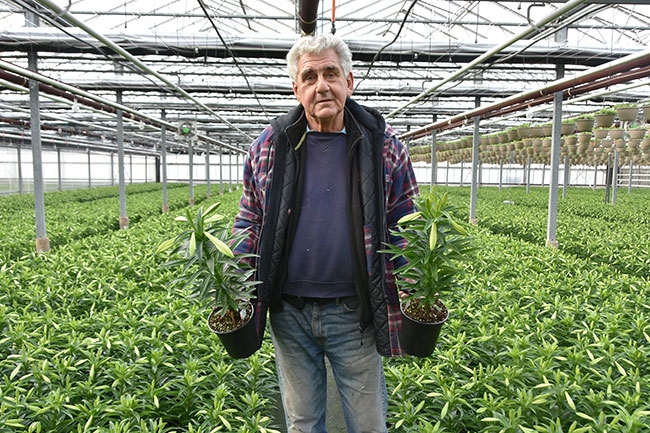
Features
Crops
Flowers
Making Easter lilies profitable again
Practices to lower costs and elevate quality.
November 20, 2018 By Melhem Sawaya
 Peter Van Beurden stands among his crop of Easter lilies at Westland Greenhouses. Even without fungicides, this lily crop has excellent roots.
Peter Van Beurden stands among his crop of Easter lilies at Westland Greenhouses. Even without fungicides, this lily crop has excellent roots. Easter lily production has declined in the last few years but it is still one of the top five potted crops in terms of sales. 10 million Easter lily bulbs were shipped this past season. In my opinion, the major drop in sales is due to the extra cost of production with minimal increase in selling price.
Low profit margins lead to the lack of marketing programs to promote Easter lily sales, so many growers stop producing them and exposure to the lily crop dies down.
The purpose of this article is:
- To point out to buyers – whether broker or chain store – that they should pay the costs so growers can have the margin to grow this crop again. If higher volumes are sold, input costs will be stabilized because higher volumes lead to lower input costs.
- To share a few pointers from my experience in growing this crop for 40 years. They may (or more likely will) increase the return on your investment, and you can look forward to growing a crop with lots of rejuvenated potential.
Varieties
The cultivar ‘Ace’ was the predominant choice between 1960 and 1970. Since 1980, ‘Nellie White’ has been the primary cultivar and continues to the present. Another option is new cultivar ‘Chilly White’, which has a smaller bulb circumference but can produce high bud counts.
Production-wise, Ace takes the longest time to produce in the greenhouse because it has more leaves to unfold but potentially more buds than Nellie White. The new cultivar Chilly White take less time to produce with its smaller buds.
As with any genus, more and smaller flowers lead to faster production time compared to larger or double flowers of the same genus.
Production pointers
Flower induction – Flower induction for lilies occurs when daylengths are longer than night. In nature, it occurs in June. This can be overcome with a cooling period of six weeks, placing moist bulbs at an optimum temperature of 6˚C – a process called vernalization. The reality is, vernalization can happen at any temperature less than 16˚C. Shipping temperatures should always be taken into consideration so overcooling does not occur. Lily bulbs should be shipped at temperatures 17 to 18˚C. Any temperatures above this will speed up sprouting. Overcooling can cause:
- Decreases in leaf and flower number, as well as leaf length at the base
- Decrease in time from emergence to flower
- Earlier and more uniform shoot emergence
- Increase in internode length
Vernalization can be done in four different ways:
- Naturally – done after the bulbs are planted and rooted in pots
- Controlled temperature forcing (CTF) – also done after the bulbs are planted and rooted, in pots or cases
- Interrupted – first partly cooled in cases, then planted and rooted, and then cooled again for the remainder of the cooling period
- Case-cooled
Pot-cooling is a much better way to go, mainly because your bud count will increase by one, on average.
Planting – Here are some key pointers during planting:
- Bulbs should be dipped in a fungicide for Rhizoctonia and an insecticide for bulb mites. Applications of fungicides and insecticides after planting will leave the media too wet, which will lead to more diseases and slower rooting.
- Peat moss from bulb packing should not be used for planting unless it is mixed well with the rest of the planting media.
- Do not pack the soil, and water so it is moistened well but not drowning. This is vital so the bulbs can get all the oxygen they need.
Fertilization – Watering practices determine the fertilizer concentration to be used. Lilies need all the oxygen they can get, especially at the beginning until visible bud because the leaf mass is small. Light watering overhead with an EC of 2 dS/m is more than enough, so frequent watering is needed. Checking EC’s and PH is most important in avoiding root damage due to high salts. Lilies also likes PHs above 6.2 to avoid leaf scorch and to make calcium and magnesium more available to the plant. EC’s target is 1 using the ‘two parts water to one part soil’ method. Controlling soil EC can avoid the need for fungicide drenches.
Height control – There are many ways to control the height of lilies. The most important ones are better for plant quality, and include cultural practices, environmental control and chemical control.
Cultural practices include:
- The cooling method – pot-cooled lilies do not have that stretchy leg at emergence compared to case-cooling
- Plants should be forced at 16 to 17˚C for height control and better bud set
- When close to bud set, normally when stem roots are visible, dropping the temperature to around 10 to 12˚C will result in better bud set and will translate to an extra bud in general
- Low-volume watering at the beginning of forcing is essential to growth control
- Space the plants before visible bud and the thick canopy of leaves will keep the plants shorter
- High phosphorous fertilizer will also cause some stretch
Environmental factors include:
- Light levels – the higher the light intensity, the shorter the plants
- When cloudy, day temperature should stay lower for the whole day; this is not DIF (more later), just a lower temperature with low light
- Lower humidity is a big factor in having shorter plants and a vital aspect for calcium uptake by the plant
- Make sure no incandescent light bulbs are lit close by because this will increase the ratio of far red to red light and that will stretch the plants
- Closing the blackout curtains half an hour before sunset will block the far red and help in controlling height. Total black out is needed. Half functional blackout curtains will increase far red light
- DIF is the difference between daytime temperature and nighttime temperature. Warm nights and cool days will keep the plants shorter, while cool nights and warm days will stretch the plants. A few pointers for using DIF properly:
- Leaf expansion has to occur before DIF can work
- If day light intensity is lower than 400 fc, DIF will not work; that is why high light glass greenhouses are better for DIF
- A photoperiod of 13 hours; 13 hours of darkness is needed for DIF to work, that is one reason why greenhouses with blackout curtains work better
- I do not recommend temperature dips (by 15 degrees or more) in the mornings because many other negative side effects can take place. A dip is when we drop the morning temperatures to below 10˚C for a few hours
- Temperature to drop (by 3 to 4 degrees) in the morning as close to sunrise as possible
- The greater the difference between day and night temperatures, the greater the effect
Using chemicals for height control can reduce the quality of the plant and have negative effects:
- Greater chance of yellow leaves
- Hollow stems when Sumagic is used, which causes the lily stems to become weak
Fascination – Fascination is mainly GA4, GA7, and BA used to slow down or prevent yellowing of the bottom leaves of lilies. One spray 3 to 5 cm above the soil level will stop any yellowing of leaves. No need for two sprays because you will increase the chances of plant stretching. Some growers do it twice because they do not know if the first time was done right. It’s a much better idea to make sure Fascination is sprayed properly the first time.
Diseases – Lilies are prone to Rhizoctonia, Phytophthora and Pythium only when cultural practices are not followed properly. In the last 20 years, we have not applied any fungicides to the lily crops and the roots have been better than ever.
Insects – Aphids, spider mites and fungus gnats are very often seen on lilies, so an application to control these pests is almost a must.
Ending thoughts
I wrote this article because I know there is money to be made in growing Easter lilies if growers follow the right cultural practices and do not have to take a lot of extra correctional steps:
- Fungicide drenches
- Moving plants
- Spraying growth regulators unnecessarily
- Shrinkage due to timing, speculated sales, quality and/or not managing space properly so you still can have a spring crop
In all my 40 years in the greenhouse business, I saw the best Easter lily crop this past Easter at Westland Greenhouses in Jordan, Ontario. This was not by chance, but by the commitment of the management team in doing everything that was required on time and correctly the first time around, so we did not have to do it a second time. Easter lilies are one of those crops that actually talk to you if you look and listen and do the things needed to be done on time.
What makes a great grower? 15 per cent is knowing what to do, 15 per cent is knowing how to do it, and 70 per cent is doing it on time.
Melhem Sawaya of Focus Greenhouse Management is a consultant and research coordinator to the horticultural industry. You can reach him by email at: mel@focusgreenhousemanagement.com
Print this page








